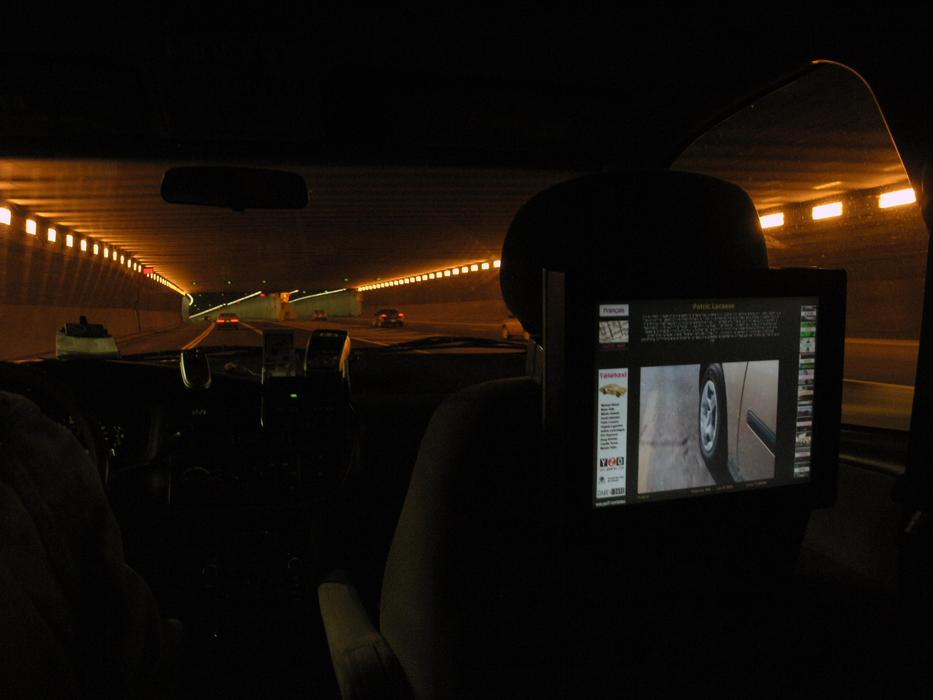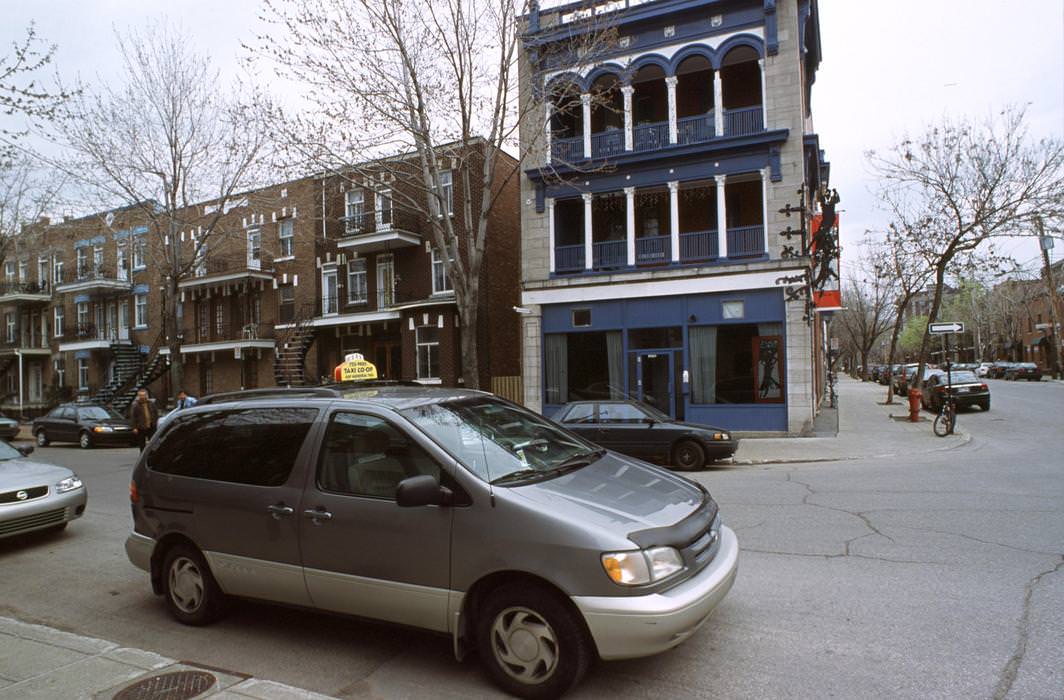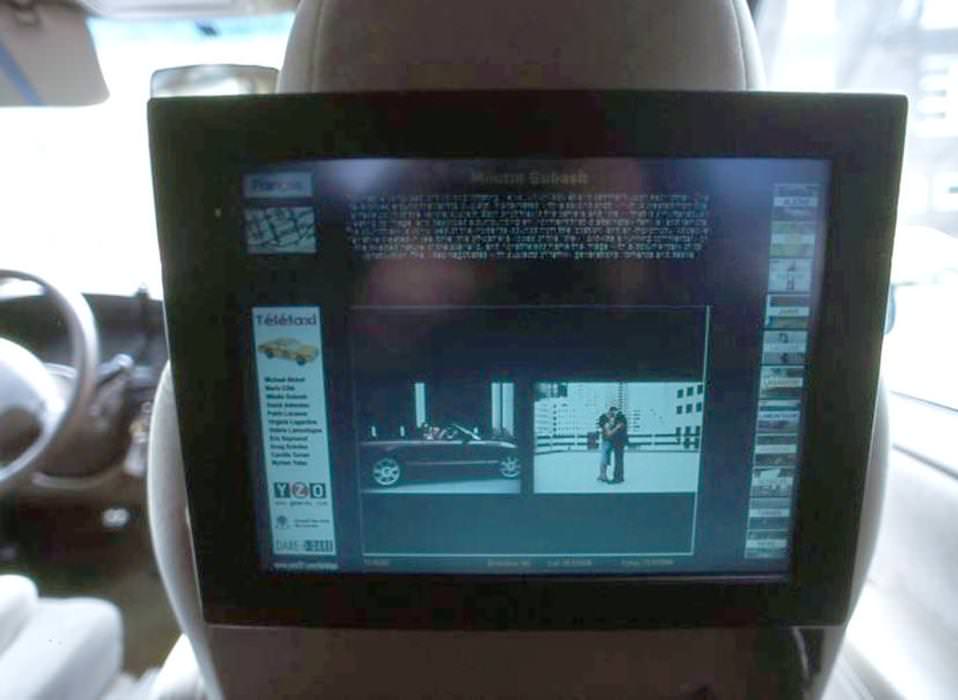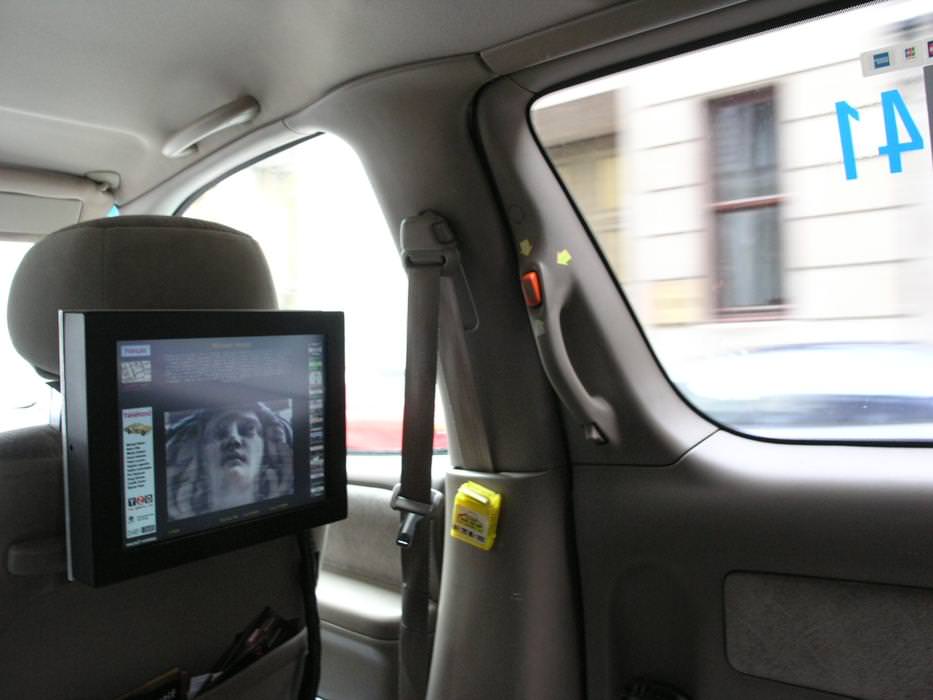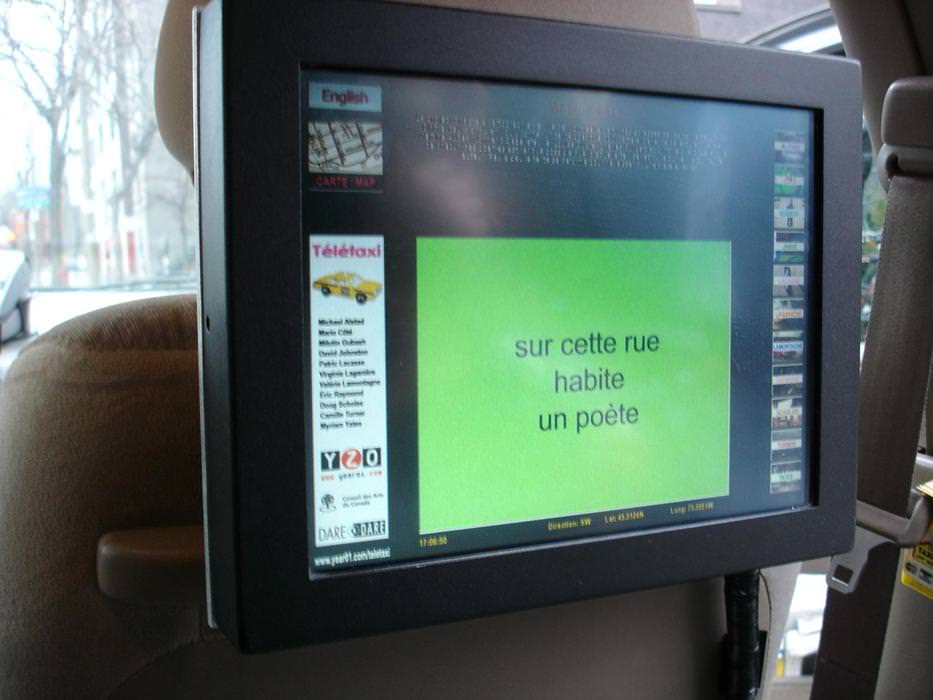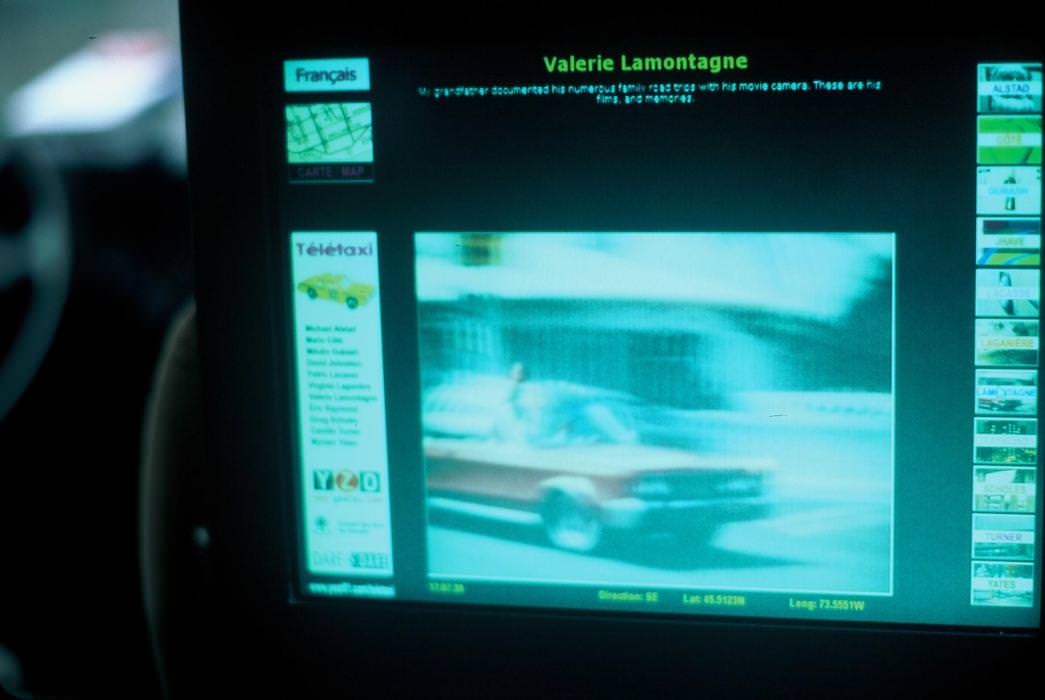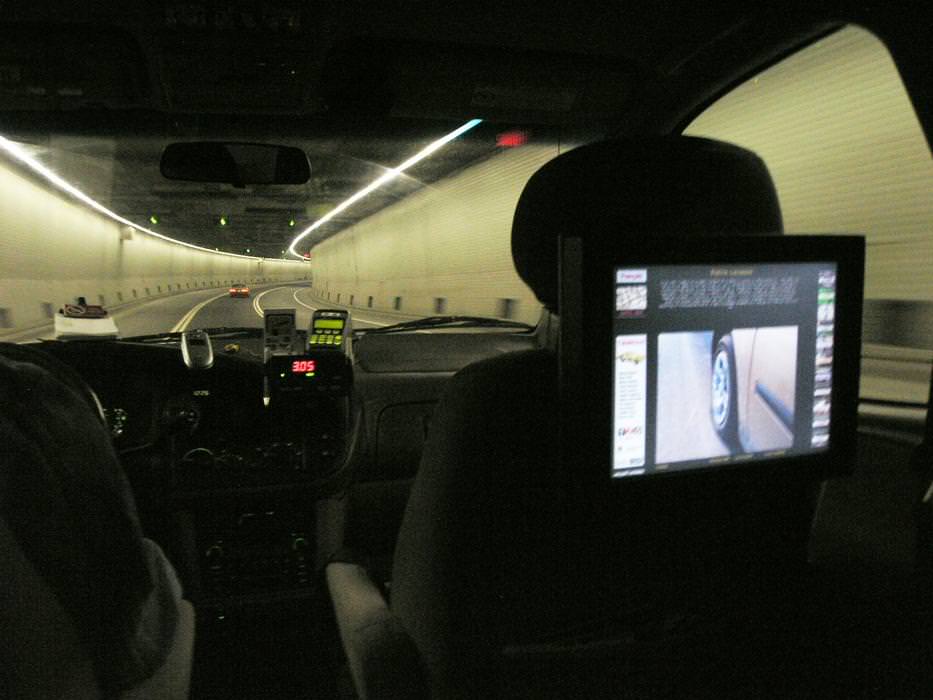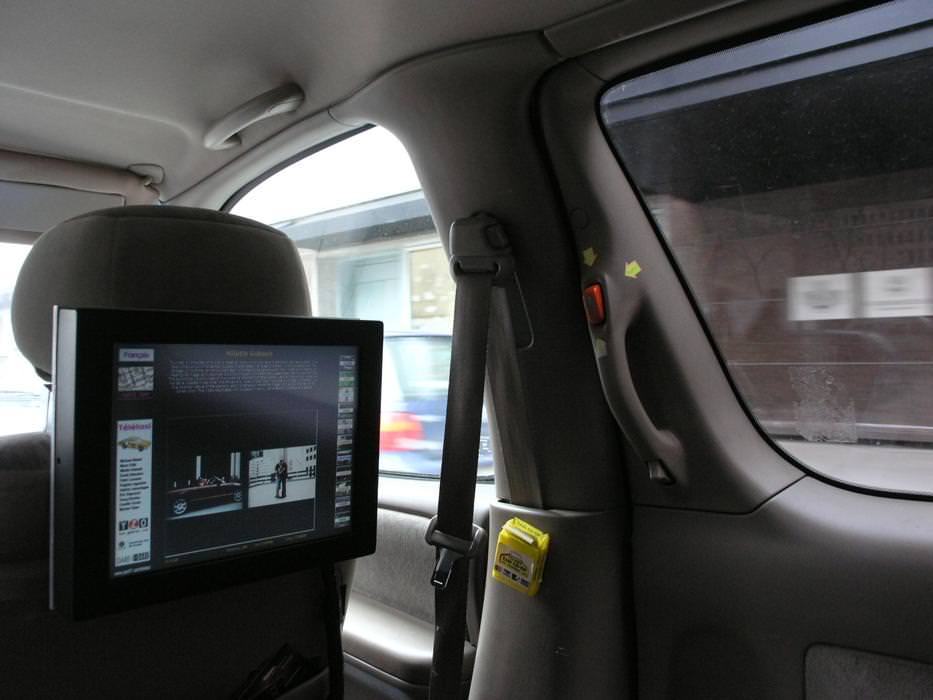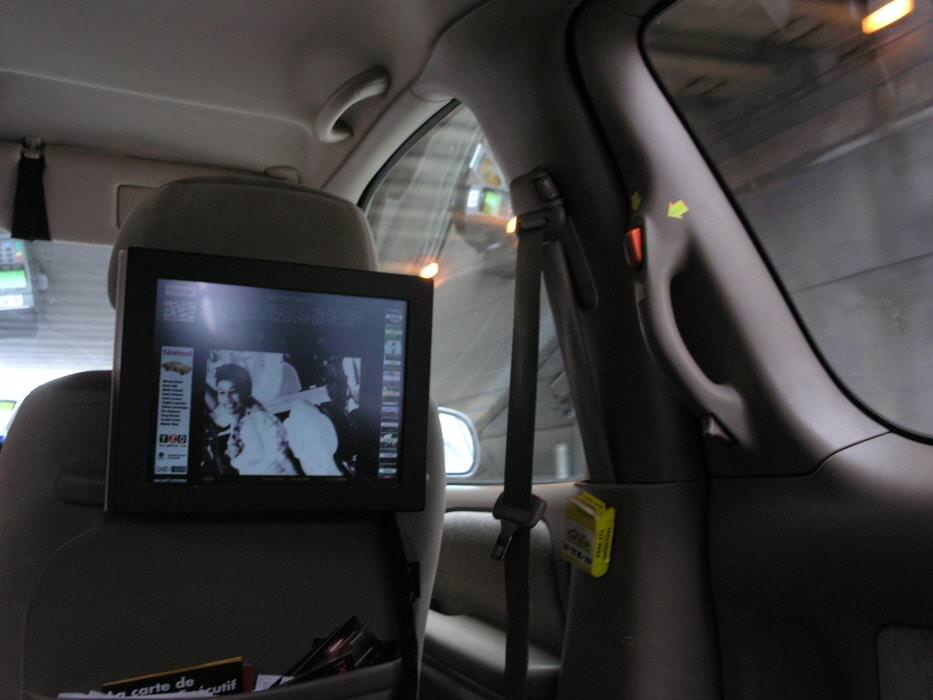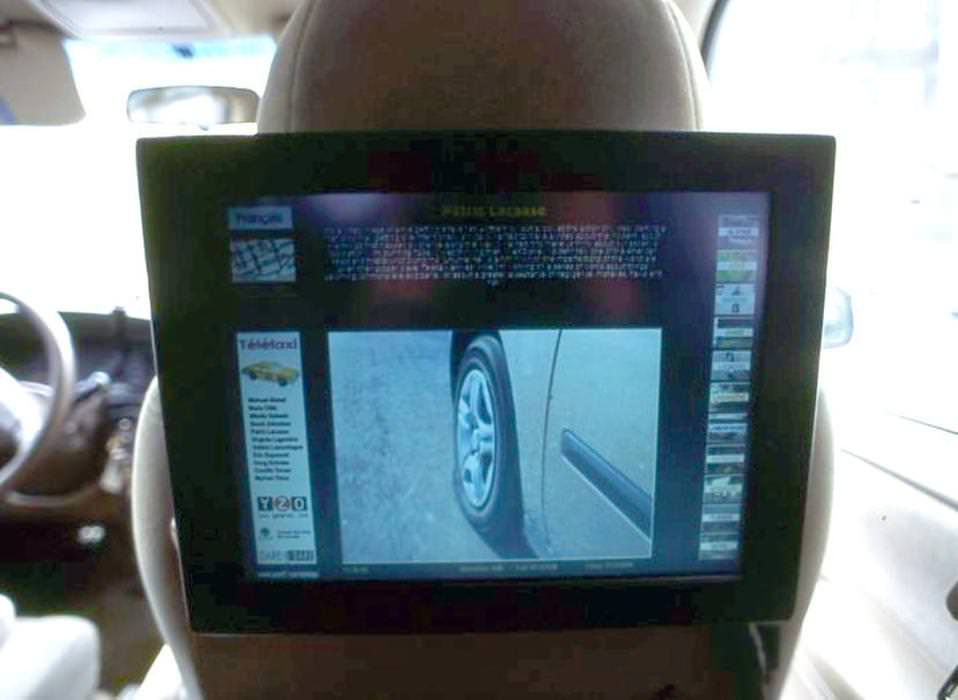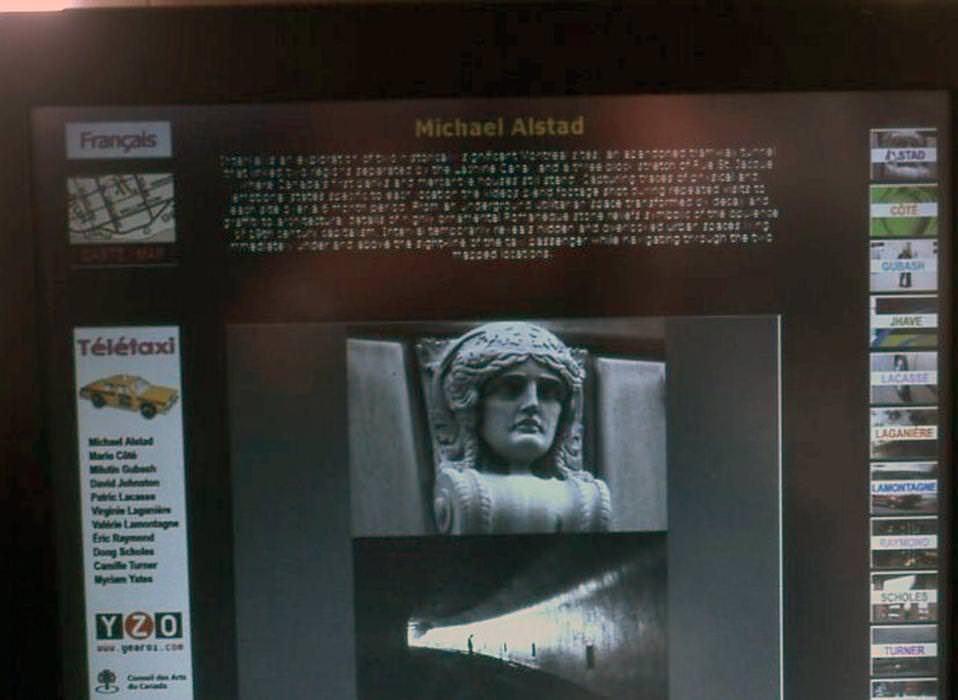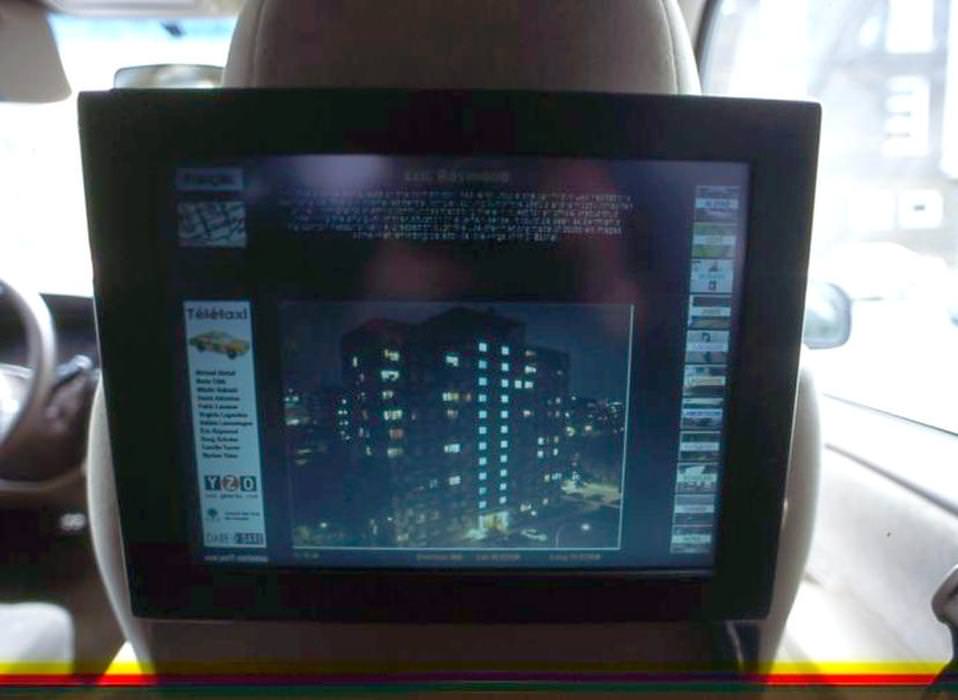Programming
Télétaxi
Video installation in a cab
At first glance, Teletaxi does not differ from the other taxis circulating in the streets of the city, but passengers who use it discover an interactive video screen at the rear of the vehicle. At random, passengers-viewers watch short animations and videos made by 12 artists.
View more
March 21 to June 21, 2005 Opening Friday, April 1 from 5 pm to 9 pm at Viger Square (West Square)
Curator: Year Zero One with the support of the Montreal Urban Research Center
For a visit, contact Taxi Co-op Montréal at 514 725 9885 and ask for the vehicle # 235
At first glance, Télétaxi does not differ from the other taxis circulating in the streets of the city, but passengers who use it discover an interactive video screen at the rear of the vehicle. At random, passengers-viewers watch short animations and videos made by 12 artists. These works last between 15 and 45 seconds and appear when the taxi crosses a particular intersection or passes near a specific location. The presentation device of the works is linked to a geographical positioning system (GPS) that can locate a vehicle geographically. Teletaxi uses this technology for artistic purposes. He uses GPS to match the appearance of works with intersections that the taxi cross.
The participating artists created works based on the context of the city of Montreal (geographic, historical, social, political or other). They chose places in the city - intersections, parks, businesses, public buildings, historic sites, red light, Latin Quarter, etc. - and worked from them. The works carried out explore notions such as surveillance, psychogeography, mapping, information architecture, the city-entertainment and the relationship between the private and the public. Télétaxi offers an artistic and quite unusual experience to the Montreal public. It integrates art into everyday life and allows an incursion of the imaginary into everyday life.
On the day of the opening, Télétaxi will be available to the public and will make the round trip free between Square Viger and the circuit of artworks throughout the city. After that, it will be possible to reach this taxi by phone or to hail it by chance in the city.
Founded in 1996, Year 01 is an artistic collective established in Montreal and Toronto. It acts as a dissemination network for digital culture and new media. The group has produced several media art events including Télétaxi Toronto (an exhibition presented as part of Tranz Tech International Media Art Biennial), Signal (an exhibition of telematic art), Transmedia 2002-Fifteen Seconds of Fame (an exhibition of video art on outdoor screens in Toronto) and several web art events.(www.year01.com)
Myriam Yates (Montreal) presented her work in photography and video at various solo and group exhibitions, including at Gallery 44 (Toronto), La Centrale and Skol, and the Musée régional de Rimouski. In 2004 she participated in a residency at the Banff Center on the theme of Intra-nation.
Camille Turner (Toronto) is a multidisciplinary artist dedicated to interactive installation and textile art. She has presented her work at many international events including the Dakar Biennial. She has just completed a two-year residency as an artist in the Harbourfront Center's textile studio, a cultural and arts complex in Toronto. She is a member of the Year 01 collective.
Doug Scholes (Montreal) works the objects and maintenance mainly through installation. He has exhibited at CIRCA, Verticale Gallery, the MacLaren Art Center, the Georgian College Art Gallery, the Bau-XI Gallery, TruckGallery, Trianon Gallery, and Lethbridge University Art Gallery, Alberta. He is a member of the Montreal Urban Research Center. www.crum.ca
For more than fifteen years, Éric Raymond's (Montreal) artistic career has taken him into the fields of installation, video, web art and robotics. He has presented his work across Canada and in the United States. He is a professor at the School of Visual and Media Arts at the University of Quebec in Montreal. www.eric-raymond.com
Valérie Lamontagne (Montreal) is an artist, art critic and curator. She has mainly realized performances, installations and web works. Her work has been regularly presented since 1997, including exhibitions at Open Space Gallery (Victoria, 2003) and Galerie Plein Sud (Longueuil, 2000); Hamilton Artists Inc. (Hamilton, 2000). She currently teaches Digital Image/Sound program at Concordia University.
Virginie Laganière (Montreal) is pursuing a Master's degree in Visual and Media Arts at UQAM. Her work (videography, sound performances and media installations) was shown at events in electronic art organized by Champ Libre, Perte de signal and Périphérique, and within collaborations at AXENÉO7, Daïmon and at Galerie de l'UQÀM.
The installations of Patric Lacasse (Montreal) were presented in several group exhibitions. In 2002 he exhibited solo at the Skol art center. In 2003, he took part in the Manif d'art de Québec and the SoToDo International Art Performance Congress in Berlin.
David Jhave Johnston (Montréal) is a multimedia poet. He has exhibited with Symbiosis Collective, written and directed multimedia theater with the Unconscious Collective and recorded electronic spoken word for the label ZOI. He is frequently invited as a speaker in lectures dedicated to Web art. He is also a member of the Year01 collective. www.glia.ca
Milutin Gubash (Saskatoon) has exhibited across Canada (Montreal, Toronto, Saskatoon, Edmonton, Vancouver) and Helsinki, Finland. In 2005, he will present his solo work at Gallery 44 (Toronto) and VU (Quebec) during the Quebec's Manif d'art. He is currently responsible for the University of Saskatchewan's Photography and Digital Image Program.
Mario Côté (Montréal) painting, video, photography and sound works are at the heart of his projects. He has participated in numerous exhibitions in Canada and Europe. His videos are regularly selected by international festivals. He is a professor at the School of Visual and Media Arts at the University of Quebec in Montreal.
Michael Alstad (Toronto) is an artist, a curator and a graphic designer. He has participated and coordinated several multimedia and in situ projects including Transmedia (2000, 2002) and Télétaxi Toronto (2003). His work has been featured in exhibitions and festivals in Toronto, Vancouver, New York, London, Sao Paulo and Graz (Austria). He is a member of the Year 01 collective. http://www.year01.com/alstad
The participating poets: Martine Audet, Louise Dupré, Normand de Bellefeuille, Charles Guilbert, Cynthia Girard.
Presented with the support of the Canada Council for the Arts and Taxi Co-op Montreal.
Year01 thanks the Canada Council for the Arts, Heritage Canada and the Mobile Digital Commons Network, Hexagram Media Research Institute (Biomachines), Éric Raymond, and the Research-Creation Program of the World UQAM (PAFARC) for the financial support of this project, the members of the Montreal Urban Research Center (CRUM) and Jim Ruxton.
Activity Report
March 21 to June 21, 2005 Vernissage on Friday, April 1 from 5 to 9 pm at Viger Square (West Square)
Curator: Year Zero One with the support of the Centre de recherche urbaine de Montréal
For a visit, contact Taxi Co-op Montréal at 514 725 9885 and ask for vehicle #235
"So where are we going? The question takes me by surprise. Actually, I'm not going anywhere. I just want to take a Teletaxi ride. Even though I studied the map on the DARE-DARE website, once seated in the cab, I was disoriented... It must be the back seat syndrome: the only desire to be guided. Arsène, the friendly driver, puts me at ease right away. He has seen others. Twisting to see the touch screen, he shows me the indications on the city map. Thanks to the GPS system, short video strips will appear according to our geographical position. On the map, the activable zones are represented by colored circles identifying each of the artists participating in the project. He suggests a route that will allow us to pierce, in one hour, as many of these multicolored bubbles as possible.
On our way, direction north. Our fluctuating latitudes and longitudes are permanently displayed at the bottom of the screen. In other words, we are being followed. As soon as we pass under the Masson viaduct, another viaduct, filmed from the same point of view, appears on the screen. Or is it the same one? While my eyes laugh at the image, the real viaduct passes over my head and into my peripheral vision. My gaze is caught by this double tracking shot. The sequence is interspersed with footsteps on a sidewalk and a flock of pigeons. Everything happens very quickly. I barely had time to try to understand what was happening when it was already over. My first motorized aesthetic experience is dazzling. A poetic injection in a banal and familiar landscape.
Our journey continues like an urban road movie where two realities meet. While the city and its inhabitants pass by like a long sequence shot through the windows of the vehicle, certain sites (intersections, buildings, passages, infrastructures) are revealed in images in the videos and animations. The view of each artist on the chosen place differs: in turn poetic, factual, intimate, voyeur, historical, personal and humorous. Some strips are anchored in the present, others look to the past, or transport us elsewhere. Boulevard de Maisonneuve: voyeuristic incursions into the Jeanne-Mance homes. René-Lévesque Boulevard: camera gravitating around a couple kissing on a roof. Rue de Lanaudière: quote from a poet who lives on this street. Ville-Marie highway: fixed shot on a wheel that deflates repeatedly. Turcot interchange: collage of multiple views on this concrete jungle. In front of Windsor Station: historical information about the black population that worked there in the past. Boulevard Saint-Laurent : archive film of a family on the road...
I have plenty of time to catch my breath between the activable zones. The territory to cover is vast and the sequences last less than a minute. So I navigate on the touch screen to get an overview of the projects. When I'm stopped, I compose with my fingertips an abstract work that disappears as soon as the vehicle starts moving again. Arsène and I take advantage of the time in between to discuss our visions of the Teletaxi. He would like to see advertising, which is undoubtedly more profitable than artistic projects. "How about permanent artistic interventions in your cab, would you like that?" He agrees, as long as the customers would have the choice to watch them or not...
His comment leaves me perplexed. We can develop all imaginable strategies to make contemporary art accessible to the public, to surprise them, to reach them in their daily life where they least expect it, but advertising remains the undisputed champion in this field. As Teletaxi uses a device conceived for publicity, Arsène observed a certain reticence among the customers to his contact. As soon as he explains the artistic nature of the project, they relax. He appreciates the fact that, focused on the screen, they forget to look at the speedometer and to watch their driving, becoming more patient and courteous. Driver-passenger relations are all the better for it. Have we invented a new form of art therapy for road rage?
It is on these reflections that my race ends on board the mobile gallery. We have come full circle without having seen all the works. It's only a postponement. I'll have to be patient though, because at Taxi Co-op, car 235 is in high demand these days. Notice to travelers without a destination...
